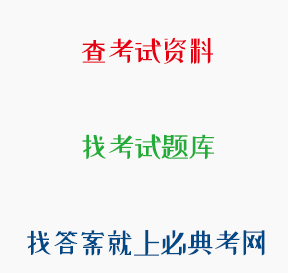正确答案: B
尊重学生人格
题目:晓茜写了一篇小说,想要寄出去发表。孙老师知道后,在班上公开批评晓茜:"话都说不利索就想当作家?你也不称称自己有几斤几两!"晓茜当场羞红了脸。孙老师的做法违背的师德规范是()。
解析:《中小学教师职业道德规范》(2008年修订)"关爱学生"规定,教师要关心爱护全体学生,尊重学生的人格,平等、公正对待学生。题目中的孙老师公开批评羞辱小茜,没有做到尊重学生的人格。故选择B。
查看原题 查看所有试题
学习资料的答案和解析:
[多选题]教学相长"、"循序渐进"等教学原则最早出自《论语》。( )
解析:教学相长"("学然后知不足,教然后知困。知不足,然后能自反也;知困然后能自强也。")、"循序渐进"("学不躐等"、"杂施而不孙,则坏乱而不修"、"不陵节而施之谓孙")等教学原则最早出自《学记》。《学记》相传作者是孟子的学生乐正克,这本书不仅是中国古代也是世界上最早的一篇专门论述教育、教学问题的论著。常考内容:揭示了教育的重要性("化民成俗,其必由学");阐释了启发式教学("道而弗牵,强而弗抑,开而弗达"、"君子之教育喻也");阐述了教育与政治的关系("建国君民,教学为先");因材施教、长善救失原则("人之学也,或失则多,或失则寡,或失则易,或失则止。此四者,心之莫同也。"、"叩之以小者则小呜,叩之以大者则大鸣");课内外相结合原则("时教必有正业,退息必有居学"、"藏息相辅")等。
[多选题]下列关于学校文化所具有的特点的表述,正确的有( )。
它是以有形的物质为载体的无形文化
它是一种具有相对稳定性和连续性的文化
它是一种有个性的文化
它是一种软约束性的文化
解析:学校文化的特点:(1)学校文化是以有形的物质为载体的无形文化;(2)学校文化是一种软约束性的文化;(3)学校文化是一种具有相对稳定性和连续性的文化;(4)学校文化是一种有个性的文化。
[多选题]材料:男,13岁,初二学生,不合群,经常莫名紧张,失眠,头痛,担心考试失败。父亲是保险业务员,42岁,母亲是医院护士,38岁,两人均中专学历。容易感冒,尿床,从五年级开始远视眼,情绪会不安定,和同学打架,有时在学校里会恶心,呕吐,并伴有攻击行为。作业经常完不成,要求周一上交的,周天晚上才准备写。学习热情不高,并且有厌恶感,课文朗读需要用手指指着读,并且阅读起来会跳行,计算也容易搞错。
问题:
(1)该中学生存在的主要心理问题是什么?
(2)问题产生的原因有哪些?
(3)作为一名学校心理辅导老师,你将采取什么咨询与辅导方法,该方法原理与步骤是什么?
[单选题]针对中小学生常见的"言行不一"问题,德育应( )。
具体情况具体分析
解析:德育过程有多种开端,不一定都从知开始,也可以从情、意、行开始。言行不一的原因有很多,可能是认知偏差,可能是行为不当,也可能意志力不足,因此要视情况而定。故选择D。
[单选题]Passage 2
The subject of ballads, books and films,Robin Hood has proven to be one of popular
culture's most enduring folk heroes. Overthe course of 700 years, the outlaw fromNottingham shire who robs the rich to giveto the poor has emerged as one of the most enduring folk heroes in popular culture andone of the most versatile. But how has thelegend of Sherwood Forests merry out laws evolved over time? Did a real Robin Hood inspire these classic tales?
Beginning in the 15th century and perhaps even earlier, Christian revelers in certain partsof England celebrated May Day with plays and games involving a Robin Hood figure withnear-religious significance. In the 19th century,writer-illustrators like Howard Pyle adaptedthe traditional tales for children, popularizingthem in the United States and around theworld.More recently, bringing Robin to thesilver screen has become a rite of passagefor directors ranging from Michael Curtiz andRidley Scott to Terry Gilliam and Mel Brooks.
Throughout Robins existence, writers,performers and filmmakers have probed theirimaginations for new incarnations thatresonate with their respective audiences.In 14th-century England, where agrarian discontent had begun to chip away atthe feudal system, he appears as an anti-establishment rebel who murders government agents and wealthy landowners. Latervariations from times of less social upheaval dispense with the gore and cast Robin as a dispossessed aristocrat with a heart of gold and a love interest, Maid Marian.
Academics. meanwhile have combedthe historical record for evidence of a realrobin Hood English legal records suggestthat, as early as the 13th century, “Robehod,”“Rabunhod”and other variations had become common epithets for criminals. But what hadinspired these nicknames: a fictional tale,an infamous bandit or an amalgam of both?The first literary references to Robin Hood appear in a series of 14th- and 15th-century ballads about a violent yeoman who lived inSherwood Forest with his men and frequently clashed with the Sheriff of Nottingham.Rather than a peasant, knight or fallennoble, as in later versions, the protagonistof these medieval stories is a commonerLittle John and Will Scarlet are part of thisRobin's “merry”crew--meaning, at the time, anoutlaws gang--but Maid Marian, Friar Tuck and Alan-a-Dale would not enter the legend untillater, possibly as part of the May Day rituals.
While most contemporary scholarshave failed to turn up solid clues, medieval
chroniclers took or granted that a historicalRobin Hood lived and breathed during the 12thor 13th century. The details of their accountsvary widely, however, placing him in conflictingregions and eras. Not until John Majors“History of Greater Britain”(1521), for example,is he depicted as a follower of King Richard,one of his defining characteristics in moderntimes.
We may never know for sure whetherRobin Hood ever existed outside the versesof ballads and pages of books. And even ifwe did, fans, young and old, would still surelyflock to England's Nottinghamshire region for a tour of the legends alleged former hangouts,from centuries-old pubs to the Major Oak inSherwood Forest.What we do know is thatthe notion of a brave rebel who live on theoutskirts of society, fighting injustice andoppression with his band of companions, hauniversal appeal-whether he's played by ErrollFlynn, Russell Crowe or even, as on a 1979 episode of“The Muppet Show, Kermit the Frog.”
Which of the following methods is used by the author in elaborating his points?
Contrast and comparison
解析:本文讲述了Robin hood作为一个有象征意义的人物,在不同的时期,人们对于他真正的身份和来源的不同版本的介绍。作者在陈述这些内容的时候,采取了对比和比较的方法。故选择B。
[多选题]反馈是教学中的重要环节之一。简述外语教学中反馈的两种主要类型,列举教师了解学生学习情况的三种途径,以便及时给予反馈。
[多选题]下面是初中英语课堂教学导入活动中的师生对话片段,该单元的话题是“Jobs”。
T: Hi, Lily. What does your mother do?
S:He…T: Oh, no. Not“he”,your mother is a woman.You should use “she”instead of“he”.OK?
S:…Er…Mm…(不知所措)
T: Go on! What's your mother's job?
S:He is a…
根据上面教学情境回答下列问题:
(1)该教师采用了何种纠错方式?效果如何?你的判断依据是什么?
(2)该教师的纠错行为对学生的表达有何影响?
(3)针对该教师的纠错行为,提出两条建议。

 川公网安备 51012202001360号
川公网安备 51012202001360号